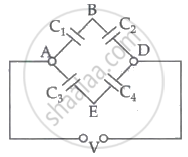Advertisements
Advertisements
प्रश्न
A point charge +Q is placed at point O, as shown in the figure. Is the potential difference VA – VB positive, negative or zero?

उत्तर
Electric potential at a distance r from the point charge +Q is given by
`V(r) = 1/(4πε_0) Q/R`
Potential at point A will be
`V(r_A) = 1/(4πε_0) Q/r_A`
Similarly, potential at point B will be
`V(r_B) = 1/(4πε_0) Q/r_A`
`because r_A < r_B`
`therefore V_A > V_B`
`therefore V_A - V_B > 0`
संबंधित प्रश्न
Show that electric potential at a point P, at a distance 'r' from a fixed point charge Q, is given by:
`v=(1/(4pi∈_0))Q/r`.
Answer the following question.
The magnitude of the electric field (in NC – 1) in a region varies with the distance r(in m) as
E = 10r + 5
By how much does the electric potential increase in moving from point at r = 11 m to a point at r = 10 m.
If a positive charge moves opposite to the direction of the electric field, the field does _______ work on charge and potential energy ________.
It becomes possible to define potential at a point in an electric field because electric field ______.
A cube of metal is given a positive charge Q. For this system, which of the following statements is true?
A test charge is moved from lower potential point to a higher potential point. The potential energy of test charge will ______.
An electric dipole of moment `vec"p"` is placed in a uniform electric field `vec"E"`. Then ______.
- the torque on the dipole is `vec"p" xx vex"E"`
- the potential energy of the system is `vec"p" * vec"E"`
- the resultant force on the dipole is zero.
Choose the correct option.
If a conductor has a potential V ≠ 0 and there are no charges anywhere else outside, then ______.
The force acting on a particle in one dimension is F = ax - 2xβ3. The corresponding potential energy V(x), assuming V(0) = 0 is given by ______.
The potential difference between points B and E of the circuits is ______.

